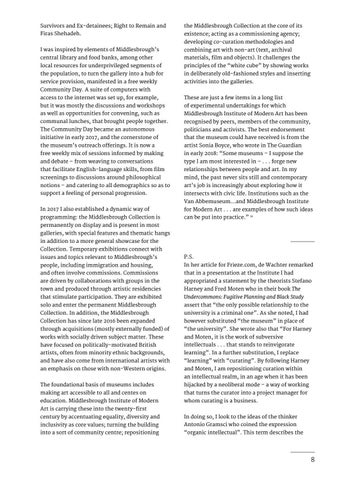Survivors and Ex-detainees; Right to Remain and
the Middlesbrough Collection at the core of its
Firas Shehadeh.
existence; acting as a commissioning agency; developing co-curation methodologies and
I was inspired by elements of Middlesbrough’s
combining art with non-art (text, archival
central library and food banks, among other
materials, film and objects). It challenges the
local resources for underprivileged segments of
principles of the “white cube” by showing works
the population, to turn the gallery into a hub for
in deliberately old-fashioned styles and inserting
service provision, manifested in a free weekly
activities into the galleries.
Community Day. A suite of computers with access to the internet was set up, for example,
These are just a few items in a long list
but it was mostly the discussions and workshops
of experimental undertakings for which
as well as opportunities for convening, such as
Middlesbrough Institute of Modern Art has been
communal lunches, that brought people together.
recognised by peers, members of the community,
The Community Day became an autonomous
politicians and activists. The best endorsement
initiative in early 2017, and the cornerstone of
that the museum could have received is from the
the museum’s outreach offerings. It is now a
artist Sonia Boyce, who wrote in The Guardian
free weekly mix of sessions informed by making
in early 2018: “Some museums – I suppose the
and debate – from weaving to conversations
type I am most interested in – . . . forge new
that facilitate English-language skills, from film
relationships between people and art. In my
screenings to discussions around philosophical
mind, the past never sits still and contemporary
notions – and catering to all demographics so as to
art’s job is increasingly about exploring how it
support a feeling of personal progression.
intersects with civic life. Institutions such as the Van Abbemuseum…and Middlesbrough Institute
In 2017 I also established a dynamic way of
for Modern Art . . . are examples of how such ideas
programming: the Middlesbrough Collection is
can be put into practice.” 11
permanently on display and is present in most galleries, with special features and thematic hangs in addition to a more general showcase for the Collection. Temporary exhibitions connect with issues and topics relevant to Middlesbrough’s
P.S.
people, including immigration and housing,
In her article for Frieze.com, de Wachter remarked
and often involve commissions. Commissions
that in a presentation at the Institute I had
are driven by collaborations with groups in the
appropriated a statement by the theorists Stefano
town and produced through artistic residencies
Harney and Fred Moten who in their book The
that stimulate participation. They are exhibited
Undercommons: Fugitive Planning and Black Study
solo and enter the permanent Middlesbrough
assert that “the only possible relationship to the
Collection. In addition, the Middlesbrough
university is a criminal one”. As she noted, I had
Collection has since late 2016 been expanded
however substituted “the museum” in place of
through acquisitions (mostly externally funded) of
“the university”. She wrote also that “For Harney
works with socially driven subject matter. These
and Moten, it is the work of subversive
have focused on politically-motivated British
intellectuals . . . that stands to reinvigorate
artists, often from minority ethnic backgrounds,
learning”. In a further substitution, I replace
and have also come from international artists with
“learning” with “curating”. By following Harney
an emphasis on those with non-Western origins.
and Moten, I am repositioning curation within an intellectual realm, in an age when it has been
The foundational basis of museums includes
hijacked by a neoliberal mode – a way of working
making art accessible to all and centes on
that turns the curator into a project manager for
education. Middlesbrough Institute of Modern
whom curating is a business.
Art is carrying these into the twenty-first century by accentuating equality, diversity and
In doing so, I look to the ideas of the thinker
inclusivity as core values; turning the building
Antonio Gramsci who coined the expression
into a sort of community centre; repositioning
“organic intellectual”. This term describes the
8












